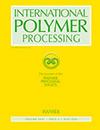Evaluation of the processing conditions on the production of expanded or plasticized wood plastic composite with cashew nutshell powder
IF 1.1
4区 工程技术
Q4 ENGINEERING, CHEMICAL
引用次数: 0
Abstract
Abstract In this work we investigate the influence of closed (“C”) or open (“O”) extrusion degassing, and low (5 MPa – “L”) or high (90 MPa – “H”) holding pressure during injection molding on the properties of wood-plastic composite (WPC) based on high-density polyethylene (HDPE) flakes compatibilized with 5 wt% maleic anhydride-modified polyethylene (MAPE), 5 wt% lubricant (Struktol® TPW 113), and 40 wt% cashew nutshell powder (CNSP). Two reference compounds were extruded with closed degassing and injected at 90 MPa of holding pressure: (1) HDPE flakes extruded with 5 wt% MAPE and 5 wt% Struktol® TPW 113 (HDPEad_C-H) and (2) HDPE flakes previously melt mixed in an internal mixer with 5 wt% CNSL (HDPEr/5CNSL) and then extruded with the same additive content (HDPEad/5CNSL_C-H). At 90 MPa holding pressure, the extract content of WPC slightly increased and CNSL acted as a lubricant and poor plasticizing agent, reducing the crystallinity and density of the additivated matrix (HDPEad_C-H), increasing the flow rate without significantly changing the tensile strength. On the other hand, low holding pressure (5 MPa) favored the volatilization and expansion of the residual CNSL in the WPC, which acted as a blowing agent improving filling of the mold cavity and avoiding sink marks. Sample extruded with open degassing (atmospheric pressure) did not significantly change the extract content, but favored CNSL diffusion from particles to matrix, which subsequently during injection molding led to its entrapment at the interface, resulting in low adhesion, especially at high holding pressure that hinders CNSL expansion and vaporization. These findings contribute to understand the role of residual CNSL of CNSP in WPC properties and thus, to strengthen the plastics recycling chain and reduce carbon footprint.评估腰果壳粉对生产膨胀或塑化木塑复合材料的加工条件
摘要 在这项工作中,我们研究了封闭式("C")或开放式("O")挤出脱气以及注塑成型过程中低(5 兆帕)或高(90 兆帕)保压对基于高密度聚乙烯的木塑复合材料(WPC)性能的影响、注塑成型过程中的低保压(5 兆帕 - "L")或高保压(90 兆帕 - "H")对木塑复合材料(WPC)性能的影响,木塑复合材料基于高密度聚乙烯(HDPE)薄片与 5 wt% 马来酸酐改性聚乙烯(MAPE)、5 wt% 润滑剂(Struktol® TPW 113)和 40 wt% 腰果壳粉(CNSP)相容。在 90 兆帕的保持压力下,对两种参考化合物进行了挤压和注射:(1) 使用 5 wt% MAPE 和 5 wt% Struktol® TPW 113 挤压的高密度聚乙烯薄片(HDPEad_C-H);(2) 先在内部混合器中熔融混合 5 wt% CNSL 的高密度聚乙烯薄片(HDPEr/5CNSL),然后使用相同的添加剂含量进行挤压(HDPEad/5CNSL_C-H)。在 90 MPa 的保持压力下,木塑中的萃取物含量略有增加,而 CNSL 起到了润滑剂和增塑剂的作用,降低了添加剂基质(HDPEad_C-H)的结晶度和密度,增加了流动速率,但拉伸强度没有发生显著变化。另一方面,较低的保压压力(5 兆帕)有利于挥发和膨胀 WPC 中残留的 CNSL,CNSL 可作为发泡剂改善模腔的填充,避免出现凹痕。采用开放式脱气(常压)挤出的样品不会显著改变萃取物的含量,但有利于 CNSL 从颗粒向基体扩散,随后在注塑成型过程中导致其在界面处被截留,从而导致粘附性降低,尤其是在阻碍 CNSL 膨胀和汽化的高保压条件下。这些发现有助于了解 CNSP 的残余氯化萘磺酸在木塑特性中的作用,从而加强塑料回收链并减少碳足迹。
本文章由计算机程序翻译,如有差异,请以英文原文为准。
求助全文
约1分钟内获得全文
求助全文
来源期刊

International Polymer Processing
工程技术-高分子科学
CiteScore
2.20
自引率
7.70%
发文量
62
审稿时长
6 months
期刊介绍:
International Polymer Processing offers original research contributions, invited review papers and recent technological developments in processing thermoplastics, thermosets, elastomers and fibers as well as polymer reaction engineering. For more than 25 years International Polymer Processing, the journal of the Polymer Processing Society, provides strictly peer-reviewed, high-quality articles and rapid communications from the leading experts around the world.
 求助内容:
求助内容: 应助结果提醒方式:
应助结果提醒方式:


